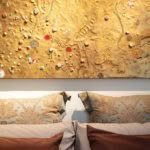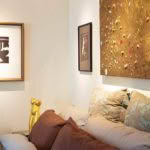Why every day is an open house for Cecilia and Megan Mickelsen, owners of Fe29 Gallery
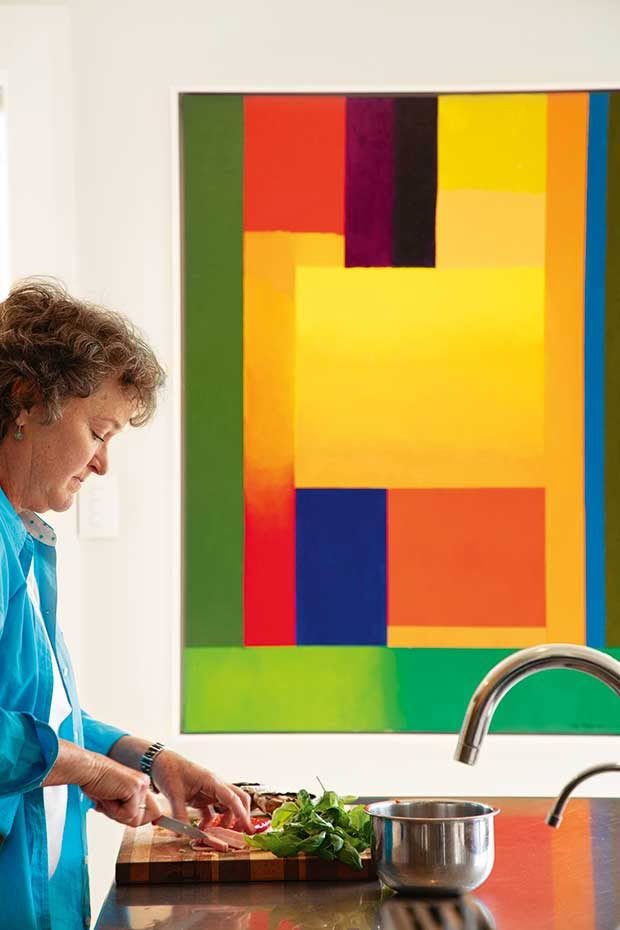
Megan prepares lunch with the full knowledge that, at any moment, a visitor may walk in and sit at her kitchen table. The painting is by Drawbridge.
A creative couple have established a gallery in their Dunedin home with everything for public view — even the art in the loo.
Words: Lee-Anne Duncan Photos: Guy Frederick
“Did you see the artworks in the bedroom? You’re welcome to have a look in there as well,” visitors to Fe29 are frequently advised.
The invitation to view art in one’s boudoir is a pick-up line as old as art itself, but Cecilia and Megan Mickelsen mean no entendre, double or otherwise. The gallery is in their St Clair home, taking up not just a room or two but filling it, including bedroom and bathroom, front and rear gardens. Almost everything is for sale.
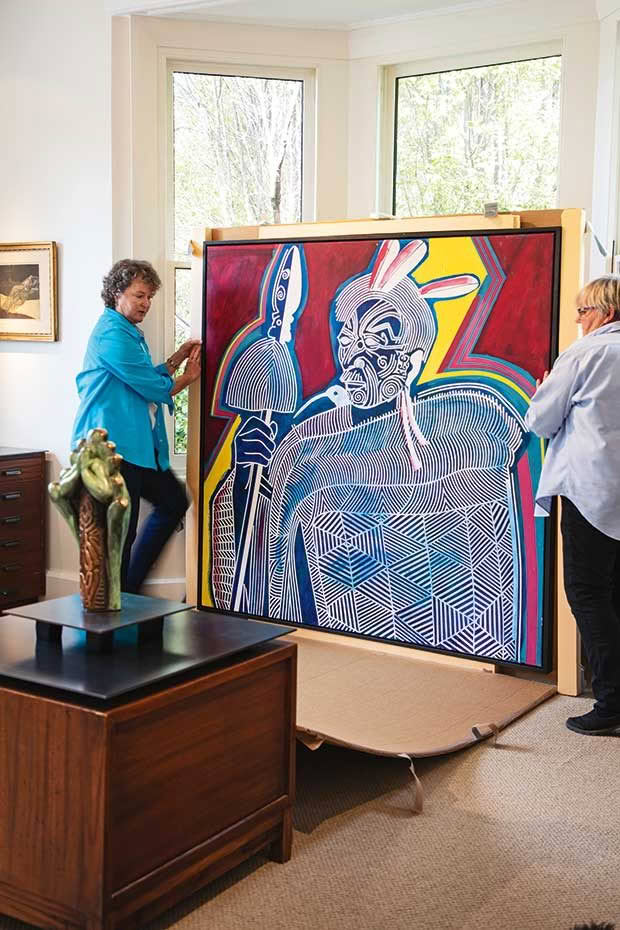
Megan and Cecilia renew the artworks on show every few weeks, this time moving a 1972 acrylic by Robert Macdonald.
When the gallery is open, Cecilia and Megan have people trooping through their most private spaces. And it doesn’t bother them one bit. This is the fourth gallery Cecilia has set up at home, and the second the pair have run together.
“It’s the best of both worlds,” says Megan. “You don’t have to drive into town, pay to park, then sit all day in a gallery you’ve paid good money to rent, not being able to do anything else as you wait for people to come in — or not.”
“Missing all of this beautiful sun,” adds Cecilia, while sitting in front of the kitchen/living area’s open bi-fold windows.

The 1920s bungalow, close enough to the beach to catch the sea breeze but not the salt spray, is a wonderful place to be, but the obvious downside is it must be visitor-ready at all times. “It’s not that hard. We both like it tidy,” says Megan.
They’re well suited. In 2008, while living in Dunedin, Cecilia met Megan, a Texan, online. “I was quite happy by myself and wasn’t looking for a partner, but I just happened to see Megan’s face and thought, ‘She looks so incredibly sweet’, so I sent her a smile.”
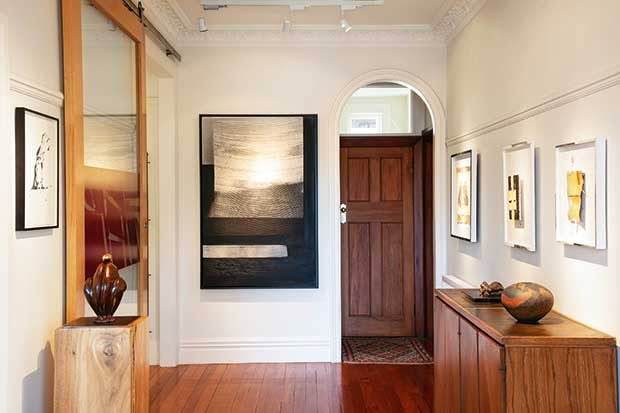
At the end of the hallway is a 1963 oil by John Drawbridge and, to the right, a series of works by Don Peebles. In the foreground is a Marian Fountain bronze and a mezzotint by Drawbridge.
Megan responded, and the two started talking. Turns out Megan is of Danish heritage (Cecilia spent several years in Denmark while working as a management consultant); Megan’s mother and grandmother were artists (Cecilia is an artist); and Megan’s mother had recently died (about the same time as Cecilia’s son).
Megan had also always wanted to visit New Zealand, but because she had many bouvier des flandres dogs and an ailing father under her care, Cecilia was freer to travel. Very soon, Cecilia had paid “an arm and a leg” for an airfare to Texas.
- Even the couple’s bedroom is open to the public.
- The bedroom includes an encaustic work by Amy Melchior (far right), a cibachrome by Di ffrench, and a John Drawbridge mezzotint.
They hit it off. Three weeks later, Cecilia returned to New Zealand, and within a couple of months Megan visited her here. They quickly decided Cecilia should close the gallery she was running in her Dunedin home, and the pair then headed to Wimberley, the small community where Megan lived just outside of Austin.
Cecilia helped Megan with her property valuation business, but before long they opened their first gallery together, initially in the centre of Austin and then in their Wimberley home.
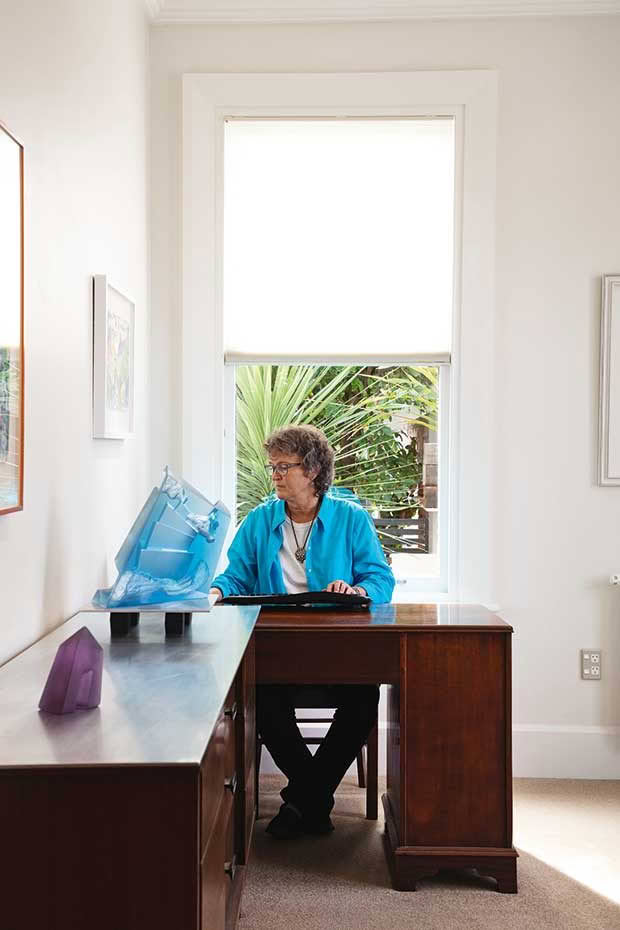
Megan and Cecilia do the gallery’s administration work themselves, including the curating, writing, marketing and media, so someone must also spend time on the computer.
Cecilia’s interest in art was sparked during her time in Denmark when she visited many galleries throughout Scandinavia and Europe.
“I was offered jobs running three galleries because they thought I knew about art. Supposedly, I picked the best pieces and talked about them knowledgeably, even though I had no formal background. I guess it was my enthusiasm. That’s what art’s all about — how it affects you personally.”
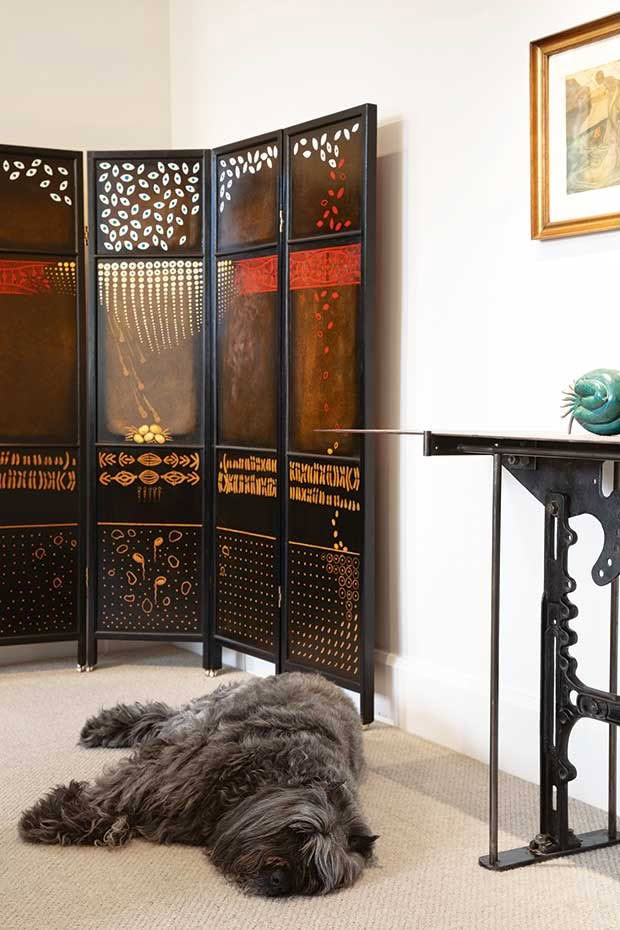
Raleigh, the 14-year-old bouvier, sleeps in front of a hand-painted screen by Marian Fountain.
Fortunately, Megan shares her taste. One time when driving through New Mexico, Megan and Cecilia overnighted in Roswell.
“We were surprised to find a couple of large art museums,” says Megan. “After going our separate ways, we met up later. I said, ‘Come with me. I’ve found the most wonderful piece, you’re going to love it.’ And she said, ‘No, come and see what I’ve found.’ And from the thousands of works of art, we had picked the same piece.”
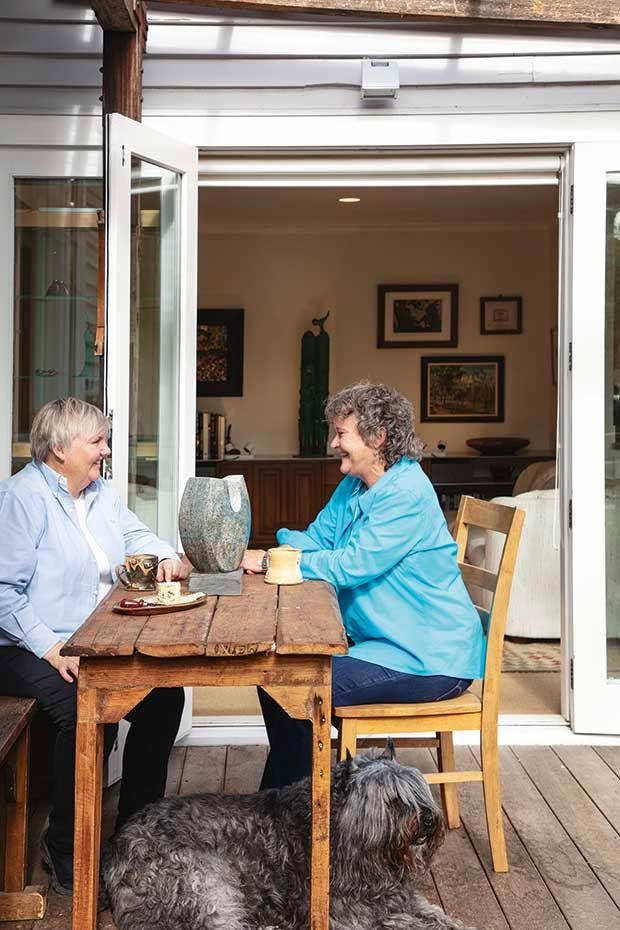
Cecilia is an artist herself, starting out creating jewellery, and building up to large works, some of which occasionally feature in the gallery.
Some years before, Cecilia had put her love of art into practice. She started making and selling copper, silver and 18-karat gold jewellery, graduating to larger artworks and architectural pieces for her son’s new Wanaka eatery.
It was called Café Fe, because it looked out onto Mt Iron and they planned to exhibit sculptures in the café’s garden. Cecilia and Megan’s gallery is called Fe29 both as a tribute to Cecilia’s late son, who died in 2006, and because of the chemical references to iron (Fe) and copper (number 29 on the periodic table).
“Also, I do a lot of collaborating, and when you put two elements together you get something completely different, like when you put two artists together,” says Cecilia. “My first claim to fame as an artist came when I sold my very first large artwork to President George W. Bush’s accountant, who had stopped into the restaurant while cycling around Central Otago.”
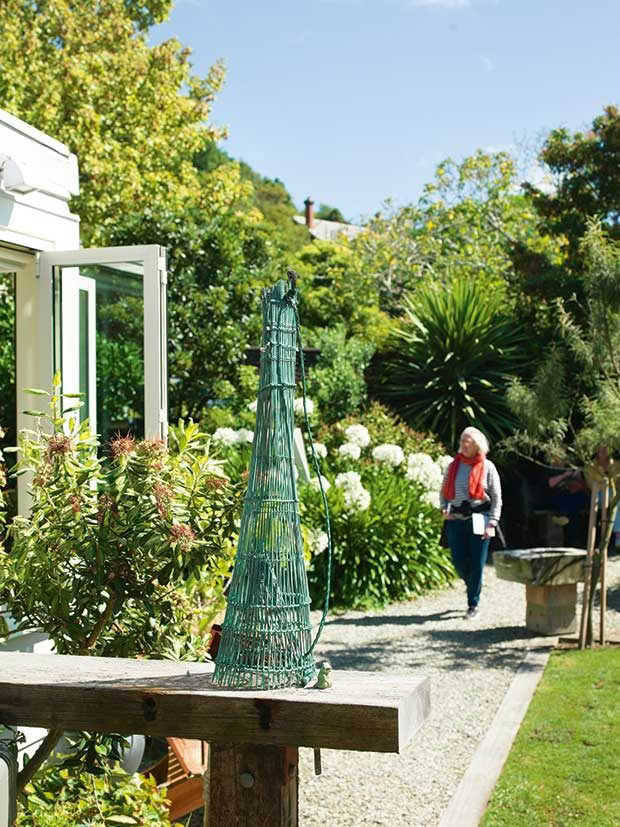
A visitor takes in Fe29 Gallery’s sculpture garden.
When her son died, Cecilia returned to Dunedin to be near her other son, former Blackcaps coach Mike Hesson, and opened her second in-home gallery. “Creating and selling art in my home helped me through a difficult time. Then I met Megan.”
Five years after meeting — and just days after California officially divorced itself from the Defence of Marriage Act — the pair married in Los Angeles, followed by a completely over-the-top ceremony back at their Wimberley, Texas, home.
“We had asked our friend, Welsh artist Edward Povey, to officiate an unofficial celebration for friends and family. We were expecting a small ceremony with about 20 people, but with Edward in charge, there was no chance of that. After weeks of preparation, it was an extravaganza. There were more than a 100 people, a fog machine, pink and green lights everywhere, and the sound of sopranos filling the entire property. It was crazy,” says Megan.
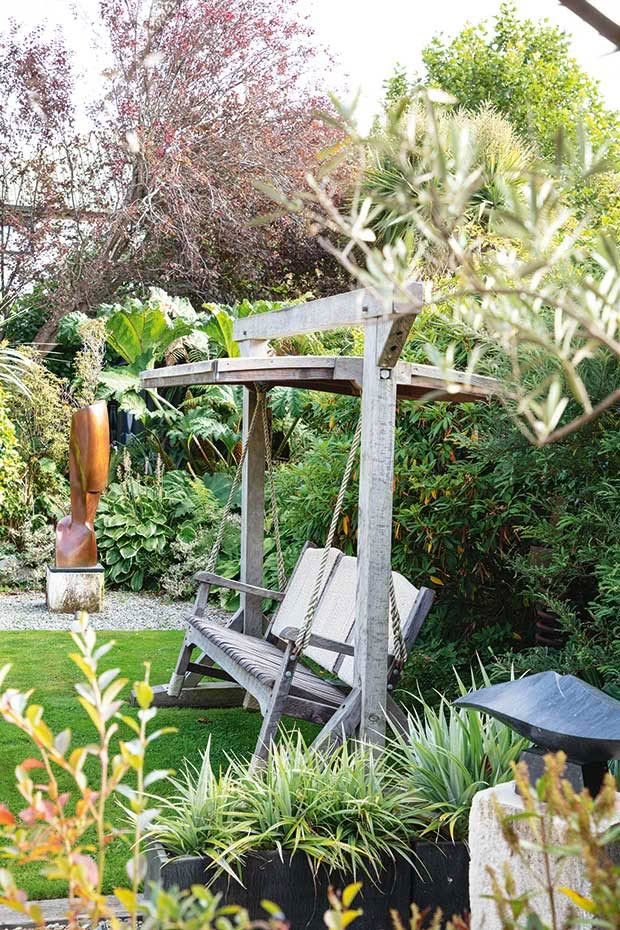
The swing by Stu Robbie is a favourite of visitors.
Megan and Cecilia are full of stories. A discussion with them is punctuated with hoots of laughter and by quick switches from one subject to another. When it comes to art, their lively stories bring the works and artists to life, which is perhaps why their gallery is a favourite place for many.
Visitors often come from far afield, including Romania, Denmark, the United States, China, Japan, Cambodia, Germany, France and Switzerland.
“It can be like the United Nations here on some days, with visitors chatting together around our table, sometimes in a multitude of languages,” says Megan. Whoever they are — serious art collectors, artists and art lovers, or just people popping by — all visitors get a warm welcome and a guided gallery tour.
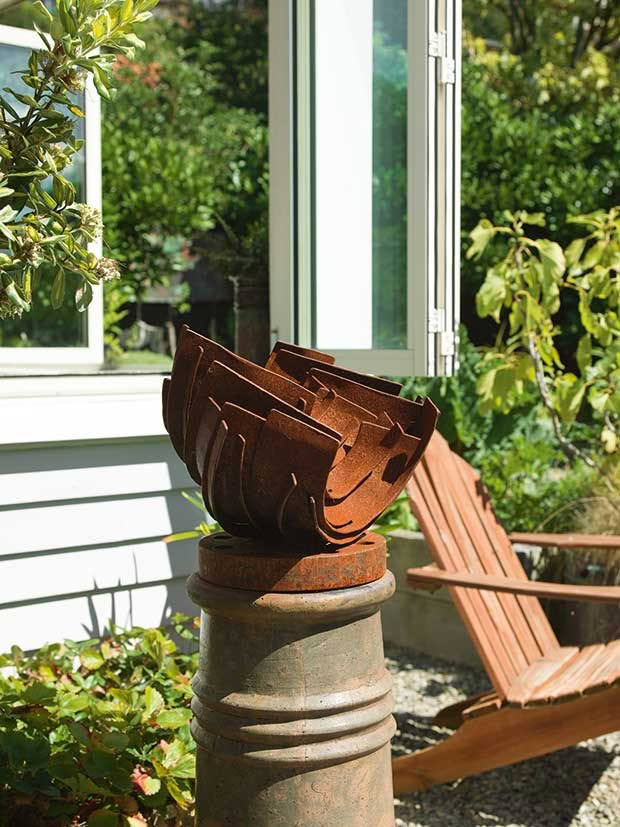
5 Square Knot by Croix Williamson.
Cecilia and Megan generally find their artists — or their artists find them — through word of mouth. “We started by showing my art and some collaborative works, and then a friend, Edward Povey, sent a large shipment,” says Cecilia. “After we opened, sculptor Peter Nicholls asked if we’d like to represent him. He loved the gallery spaces, and the grounds we had designed for large sculptures.
“On his recommendation, sculptor and jeweller Tanya Ashken popped into the gallery when she was down from Wellington for the Frances Hodgkins Fellowship 50th reunion. [Tanya was the second Frances Hodgkins fellow back in 1967.] We were delighted when she offered us her fabulous sculptures, as well as works by her late husband, John Drawbridge.”
It all grew from there. The John Drawbridge exhibition led to another exhibition, Three Friends, Three Paths, which included works from 1949 to the present day by Drawbridge, Don Peebles and Robert MacDonald.
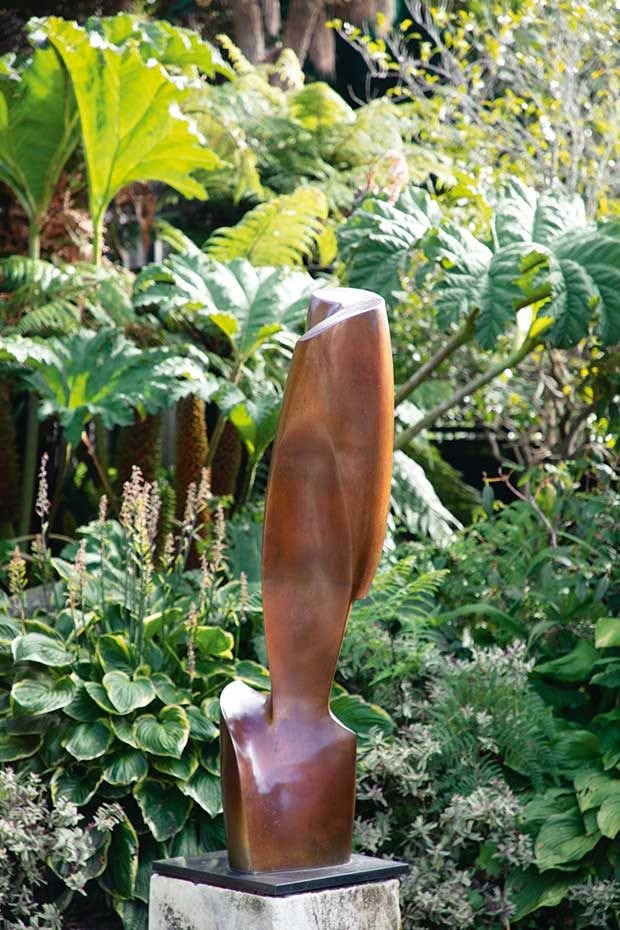
Gondwana by Tanya Ashken.
“All three, as well as Tanya, lived together in a house in London in the early 1960s and all went on to become household names,” says Megan.
Cameron Drawbridge — John and Tanya’s son — introduced encaustic artist (where pigments are added to hot wax) Amy Melchior, then Peter Nicholls asked the pair to represent his late wife, Di ffrench. He also introduced Hamish Horsley (who designed and built the Tibetan Peace Gardens in London), who in turn introduced them to mixed-media artist Simon Ogden and Marian Fountain, a New Zealand sculptor based in Paris.
Fountain’s bronze work includes sculptures, bas reliefs for the wall and medals that fit in the palm of a hand. Fe29 featured Marion’s works in an exhibition earlier this year.
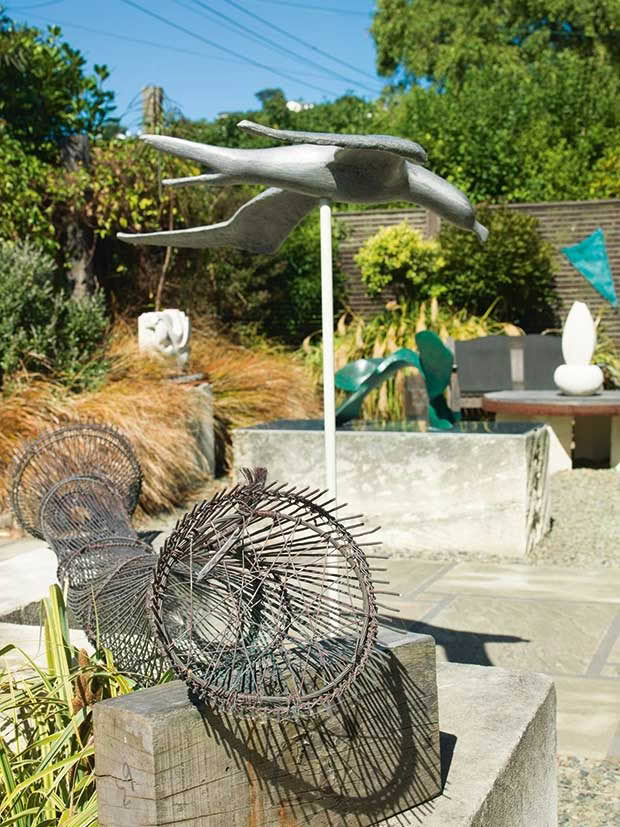
Hinake by Viv Keenan (front) and Toroa by Tanya Ashken feature in the gallery’s sculpture garden.
Other artists were found by accident. The 89-year-old landscape photographer, Matheson Beaumont, lived next door. While walking their dog Raleigh in Whanganui, Megan stumbled upon Rick Rudd’s ceramic studio, and later that same afternoon the pair bumped into cast-glass artist Emma Camden, out on her roller skates. “We had seen Emma’s work in Wellington and loved it.
We heard she was often seen around Whanganui on skates, so when a woman unexpectedly rolled into the Sergeant Gallery as we were leaving, we excitedly approached her saying, ‘You must be Emma Camden. We have been wanting to talk to you.’”
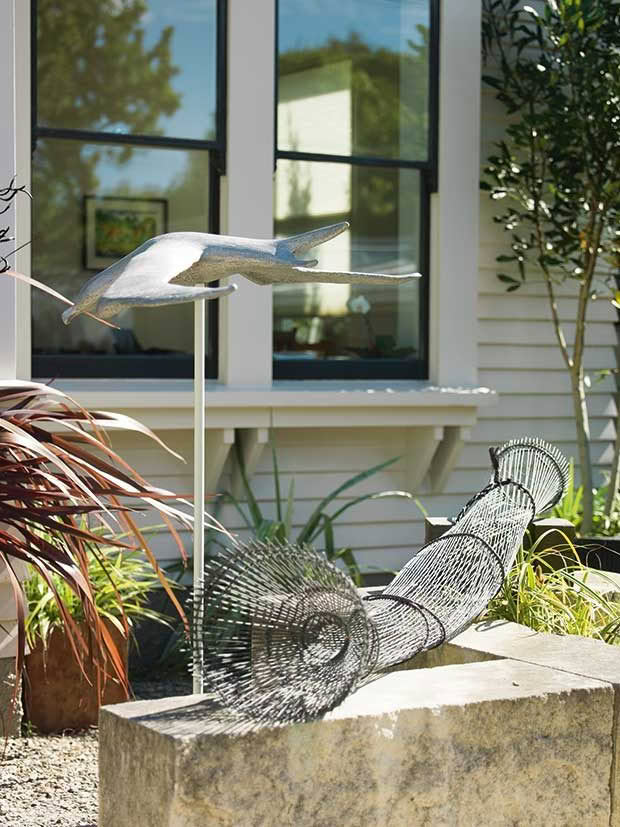
The pair also have works by Clive Barker (a film producer, novelist and visual artist from Britain, now living in Hollywood). “We even have a collection of original etchings and engravings ranging from the early 1600s by world-renowned European and Scandinavian artists,” says Cecilia.
“From the time we returned to New Zealand, it’s been our goal to create a space where artists can exhibit, and visitors can comfortably enjoy, art in a home setting.
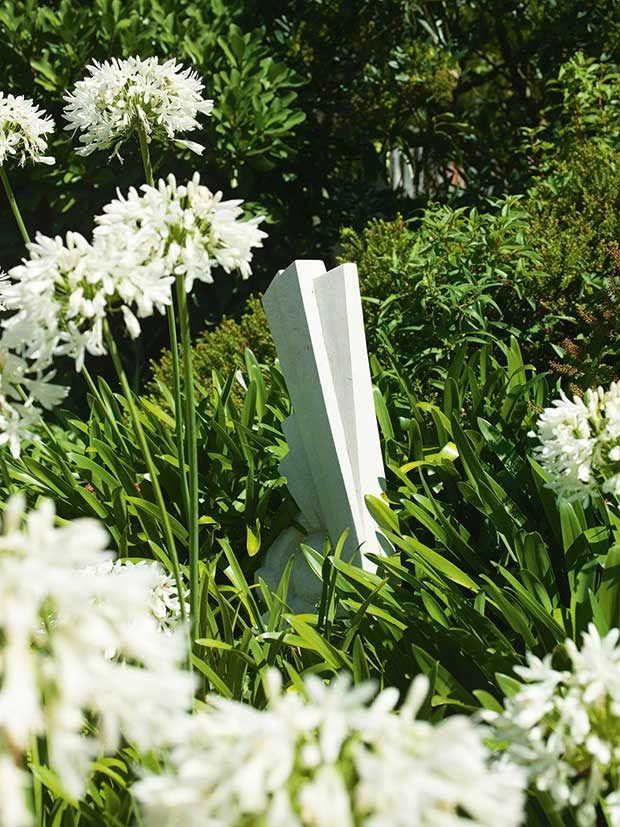
The garden includes pieces by Hamish Horsley (like this one) and Tanya Ashken. “We love sculptures,” says Megan. “They can be difficult to move around, but we love having them to offer our clients, so we wanted to have our garden ready when we opened.”
“This isn’t just our business, it’s our way of life. It’s also our way of supporting artists, showing appreciation to the people of Dunedin, and welcoming visitors to the city we have chosen as our home.”
BUYING AND HANGING ART
Cecilia and Megan’s art tips.
Don’t feel intimidated in a gallery. There are no rules on what to feel or say about a work of art. We all come from a different place and artworks will affect us in different ways. We must each enjoy art in our own way and choose what we love.
Don’t feel pressured. Galleries are places to learn about art and artists, or just to enjoy. We offer the same time and stories to everyone. You might not buy, but maybe someone you talk to about Fe29 will.
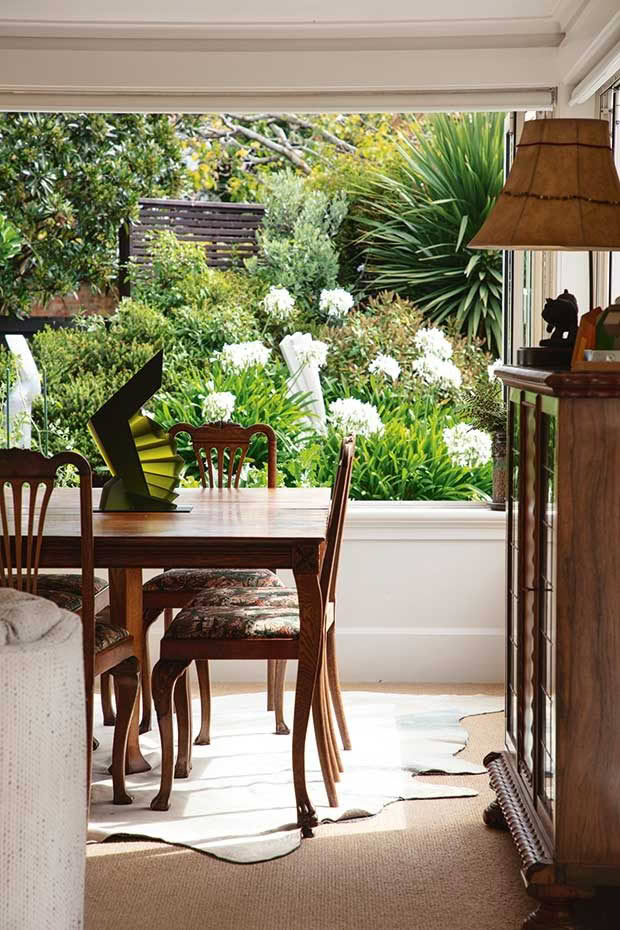
The couple’s dining table where visitors are welcome to sit, rest and chat while admiring a glass sculpture by Emma Camden.
Art for all budgets. Galleries, including ours, have works in a wide variety of price ranges and likely have a lot more works than are out on display.
Knowing a client’s budget will save time and make it easier to find something that works.
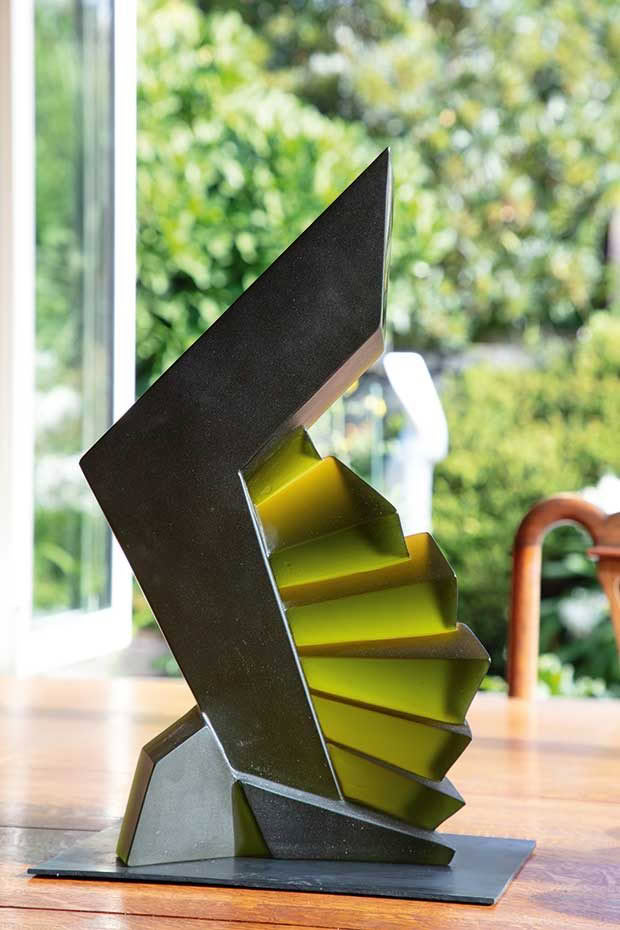
Staircase by Emma Camden.
Don’t rush into buying. We often recommend people come back for a second or third look. If they love it more each visit then it’s probably a piece for them; if not, best to move on.
Ask about lay-by. We’re more than happy to put a piece aside. It can be disappointing when a coveted work is sold.
Don’t be afraid to move works around at home. It’s amazing how different a piece can look when hung in a new place or beside other works — they can take on a new life.
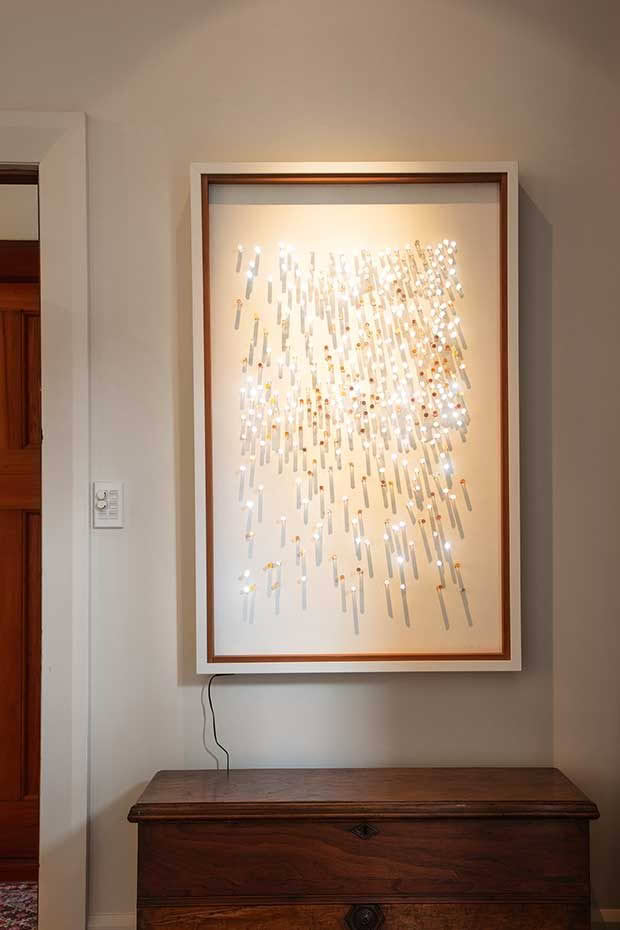
An early Perspex and light work by John Drawbridge.Mix it up. There’s no rule about hanging like with like. Antique etchings can hang alongside modern oil paintings, watercolours, wall sculptures and mixed media works. The key is the transition between works.
Get help when hanging. We are happy to assist with choosing, placing and hanging artworks.
Top hanging tip. Always use two hooks. One hook means the artwork will forever need adjusting.
CHANGING ROOMS
Megan and Cecilia change their exhibitions every four to six weeks. Solo exhibitions are usually in the front two rooms, hall and foyer, with the remaining rooms used to display works by other Fe29 artists.
Hanging an exhibition is a lot of work. Everything must be taken down, packed up and put into storage. Then the holes in the walls must be filled and painted. Furniture and sculptures are also taken into consideration to ensure they fit with the works in each exhibition.

The art in the couple’s living room changes around frequently. (From left) an oil by Edward Povey, bronzes by Marian Fountain, and antique etchings by artists including Jacques Callot (France), Carl Bloch (Denmark) and Louis Moe (Norway). Also on show are ceramics from the couple’s personal collection.
Sometimes works must be framed — usually always when they come from an overseas artist. “I lay out the new exhibitions on the computer and Megan and I review it together before final decisions are made,” says Cecilia.
“There’s the research on the artists and their work, bios and catalogues to prepare and advertising materials to be designed, printed and distributed. And that’s all before we hang the new exhibition. It’s a massive job, to which a typical gallery of this size would have a whole team assigned. We’re always delighted with the compliments from our artists (or their estates) on our curating of their shows.”
MORE HERE:
Love this story? Subscribe now!
 This article first appeared in NZ Life & Leisure Magazine.
This article first appeared in NZ Life & Leisure Magazine.
